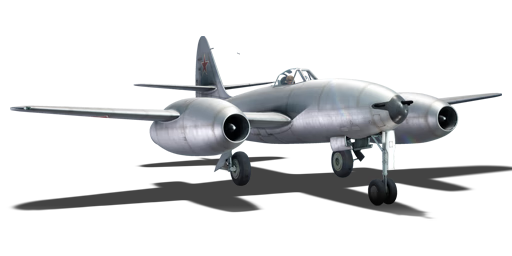



Following the underwhelming engine performance of the "Aircraft K" (Su-9) project using reverse engineered German Jumo-004 engines, the indigenous Lyulka TR-1 engines originally intended were finally completed. However, it was quickly discovered that these massive engines would require a complete redesign of the engine pods and wings to be mounted, and the tailplane changed slightly to move the elevators out of the engine's wash. As a result, the aircraft with the new wings and engines looked substantially different, even from afar. This directly resulted in it receiving new designations, first "Aircraft KM" and later redesignated into Su-11. There was also a second parallel project, "Aircraft KT" (Su-13) which would have had the Toryi (Thorium) radar from the La-200 in the nose. The Su-11 first flew on May 28th, 1947, and had a maximum speed of 940 km/h at sea level, but as flight testing quickly revealed, the aircraft had horrible longitudinal stability at high speeds. The engineers were unable to revise the airframe further to fix these stability issues, and coupled with the lack of available new Lyulka TR-1 engines, in 1948 the program was cancelled altogether, with only one Su-9, one Su-11, and no Su-13s built. Instead, the Soviet Government favoured the Mikoyan I-310 prototype (which also first flew in 1947), using the more readily available Klimov RD-45 (reverse-engineered Rolls-Royce Nene) in a more stable and reliable airframe, which ultimately became the MiG-15.
The Su-11 was introduced in Update "Ixwa Strike" as a GE premium aircraft in the Soviet tech tree. Bearing a lot of resemblance to its tech tree brother, the Su-9, the Su-11 in reality is a completely different beast. The upgraded engines and wing shape give the Su-11 unparalleled acceleration and high-speed performance compared to its adversaries at this battle rating. All in all, the Su-11 is a very powerful premium aircraft and a decent pick for people looking for something to research the early Soviet jet aircraft ranks with.
flaps
flaps
flaps
brake
| Belt | Belt filling | Armor penetration (mm) at a distance: | |||||
|---|---|---|---|---|---|---|---|
| 10 m | 100 m | 500 m | 1000 m | 1500 m | 2000 m | ||
| HEFI-T/HEFI-T/API-T | 49 | 47 | 39 | 32 | 26 | 21 | |
| HEFI-T/HEF-I/HEF-I | 6 | 6 | 5 | 4 | 3 | 3 | |
| API-T | 49 | 47 | 39 | 32 | 26 | 21 | |
| Belt | Belt filling | Armor penetration (mm) at a distance: | |||||
|---|---|---|---|---|---|---|---|
| 10 m | 100 m | 500 m | 1000 m | 1500 m | 2000 m | ||
| AP-I/FI-T | 32 | 30 | 22 | 15 | 10 | 7 | |
| FI-T/AP-I/AP-I/AP-I | 32 | 30 | 22 | 15 | 10 | 7 | |
| FI-T/FI-T/FI-T/AP-I | 32 | 30 | 22 | 15 | 10 | 7 | |
| AP-I | 32 | 30 | 22 | 15 | 10 | 7 | |







 2 x (125 / 345 / 600) %
2 x (125 / 345 / 600) % 
 2 x 190 %
2 x 190 % 

Flight performance | |
|---|---|
Survivability |
|---|
Weaponry | ||
|---|---|---|